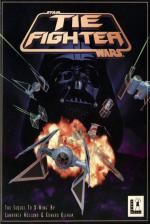
Future Publishing
 1st September 1994
1st September 1994
TIE Fighter
First there was X-Wing. Then came its two sequels, Imperial Pursuit and B-Wing. And now another game has been added to the venerable series of PC shoot-'em-ups. But Lucasarts maintain that TIE Fighter isn't just another sequel, but a completely new game in its own right.
In the unlikely event that you haven't played X-Wing or seen its movie progenitor, Star Wars, X-Wing and its follow-ups cast you as a starfighter pilot, flying for the Rebel Alliance against the Imperial forces, with your objective being to destroy the newly-completed Imperial Death Star. After 36 gruelling missions, the Death Star is destroyed and you're decorated for your services.
TIE Fighter begins where X-Wing left off, but this time you play an Imperial pilot, flying a TIE Fighter against the Rebels. At the start of the game, the Emperor summons his fleet to Coruscant City to inform you that the Rebels are in a vulnerable position. With your help, they can finally be defeated.
Although TIE Fighter employs the same basic graphics engine as X-Wing, Lucasarts have managed to produce a technically superior title. The Rubik's Cube graphics of X-Wing have been jettisoned and now all the ships actually look like ships. There's a lot more of them too: TIE Fighter features 33 previously unseen craft, including six space platforms, three different varieties of mine, a tug and a modular conveyor. The cut scenes are longer, the space station is larger and the sound is better.
However, it's not until you actually start playing the game that you notice the real refinements. The principal improvement is that each mission now has primary, secondary and bonus objectives, so you can tackle as much or as little as you want (only the primary objectives need to be completed to progress to the next mission). The mission map is now an extravagant 3D grid which highlights any area of the battle that you choose.
At launch, you can decide whether to arm your ship with missiles, rockets, bombs or torpedoes, each of which has a different blast rating and exit velocity. These correspond with the various ships' defensive ratings, as listed in the Tech room, so you can get a good idea of the weapon needed for each job. If you have to destroy a frigate, for example, the ultra-powerful Heavy Bomb is the perfect choice (although it can prove difficult getting close enough to your target to enable the weapon to do its job effectively).
In the first few missions, you fly the base model TIE Fighter, which doesn't possess shields. With two hits almost always meaning the end of your ship, a more circumspect approach to achieving your goals is required. However, that's not to say that the missions are now purely tactical exercises; unless you display blatant kamikaze tendencies, the X-Wings and Y-Wings you're up against are primitive enough to allow you to keep going for some time. In later missions, you get to fly more sophisticated craft, but the Rebel ships gain a similar boost in performance.
A useful addition is the ability to back up and restore your pilots when things go wrong - Lucasarts have finally accepted that not many people can play right through a 50-level game the very first time they try! This facility allows you to keep the medals and other decorations bestowed upon you by the Empire - even if you are vile and evil, you deserve a few perks.
TIE Fighter's major drawback is that all the missions are essentially the same: fly around for a while, shoot a few rebel ships, guard a container pod, return to base. The story does incorporate a few interesting sub-plots, in which the Emperor's agents (looking remarkably like sackcloth salesmen) recruit you for special missions, but the thrills are strictly short-term. Even when you reach the later, harder, missions in each scenario, you don't feel any compulsion to continue; rather, you're tempted to try one of the other scenarios instead, just on the off chance that it will be slightly different.
The greatest satisfaction to be gained from computer games derives from the knowledge that you've triumphed against the odds. This is lacking in TIE Fighter. No longer are you the heroic underdog fighting for a noble cause; you know that the Empire, with its huge fleet of ships, will win against the Rebels' paltry forces, and that your own efforts, no matter how spectacular, won't make a jot of difference in the long term. This is a serious deficiency - would the Star Wars movies have been so absorbing if they had depicted a series of easy victories over a technologically obsolete and numerically inferior force?
If you loved X-Wing and feel the need for more of the same, TIE Fighter is a worthwhile addition to your software collection. But although X-Wing was a superb game two years ago which can still hold its wings high today, the technically better TIE Fighter is nowhere near as enjoyable in the long term and offers nothing to support Lucasarts' claim that it's a completely original game. A sequel too far, perhaps?
Scores
PC (Windows) Version| Overall | 70% |


